Financial Accounting Assignment: Analyzing Transactions and Statements
VerifiedAdded on 2022/12/23
|22
|3227
|26
Homework Assignment
AI Summary
This financial accounting assignment solution meticulously examines the impact of various transactions on a company's financial position and profitability. It begins with an introduction to financial accounting, followed by a detailed analysis of several transactions, including credit and cash sales, purchases, returns, and payments, and their effects on the accounting equation. The assignment further delves into the preparation of sales and purchase day books, cash receipts and payments books, and the journal, illustrating how these records are used to track financial activities. Comprehensive general ledgers for various accounts, such as sales, purchases, wages, and equipment, are presented, along with a trial balance, income statement, and statement of financial position. The solution highlights the importance of accurate record-keeping and the impact of errors, providing a thorough understanding of financial reporting and analysis. The assignment concludes with a statement of financial position, presenting the assets, liabilities, and equity of the company, and an income statement, which summarizes the revenues, expenses, and net profit. The assignment helps students understand the principles of financial accounting.
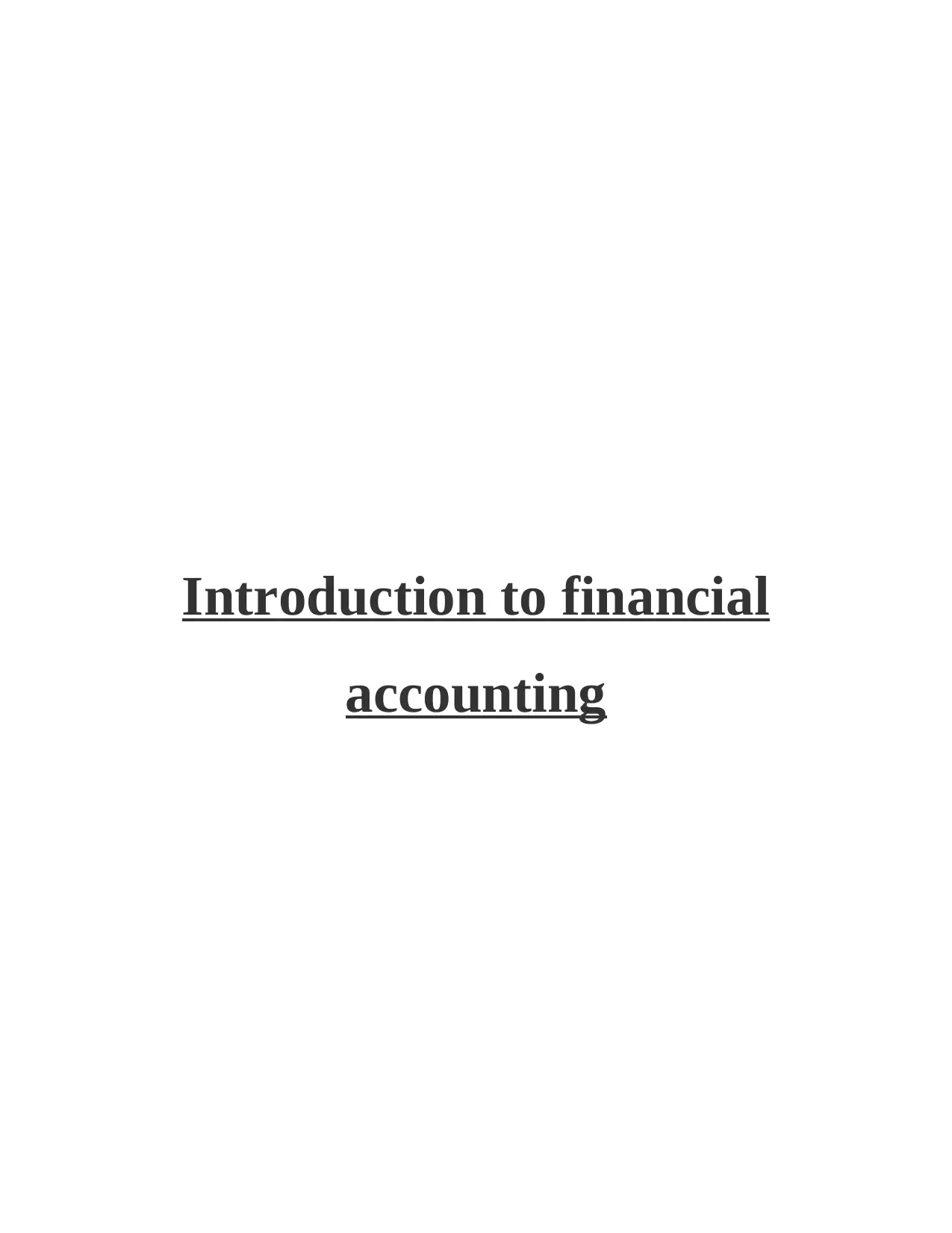
Introduction to financial
accounting
accounting
Paraphrase This Document
Need a fresh take? Get an instant paraphrase of this document with our AI Paraphraser
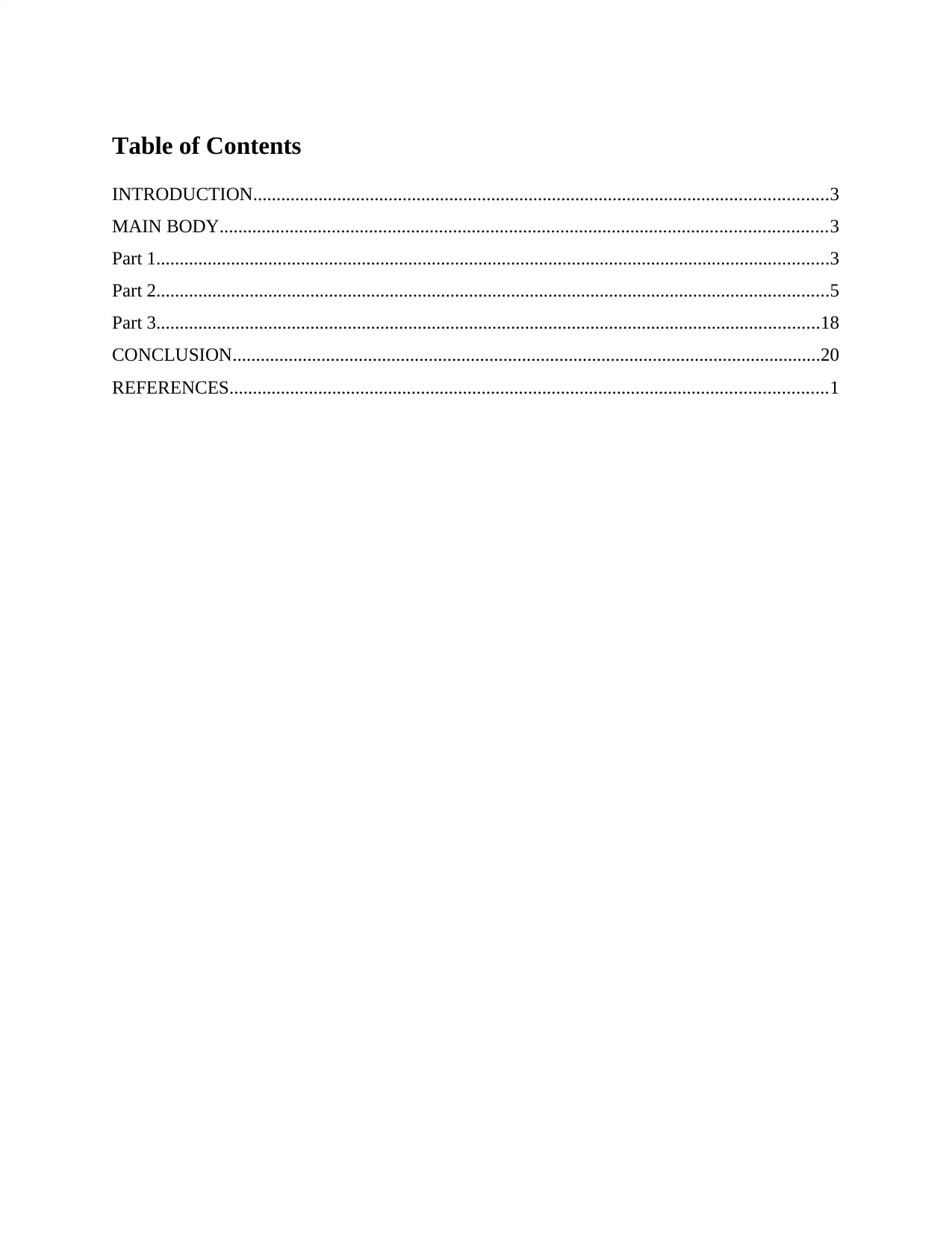
Table of Contents
INTRODUCTION...........................................................................................................................3
MAIN BODY..................................................................................................................................3
Part 1................................................................................................................................................3
Part 2................................................................................................................................................5
Part 3..............................................................................................................................................18
CONCLUSION..............................................................................................................................20
REFERENCES................................................................................................................................1
INTRODUCTION...........................................................................................................................3
MAIN BODY..................................................................................................................................3
Part 1................................................................................................................................................3
Part 2................................................................................................................................................5
Part 3..............................................................................................................................................18
CONCLUSION..............................................................................................................................20
REFERENCES................................................................................................................................1
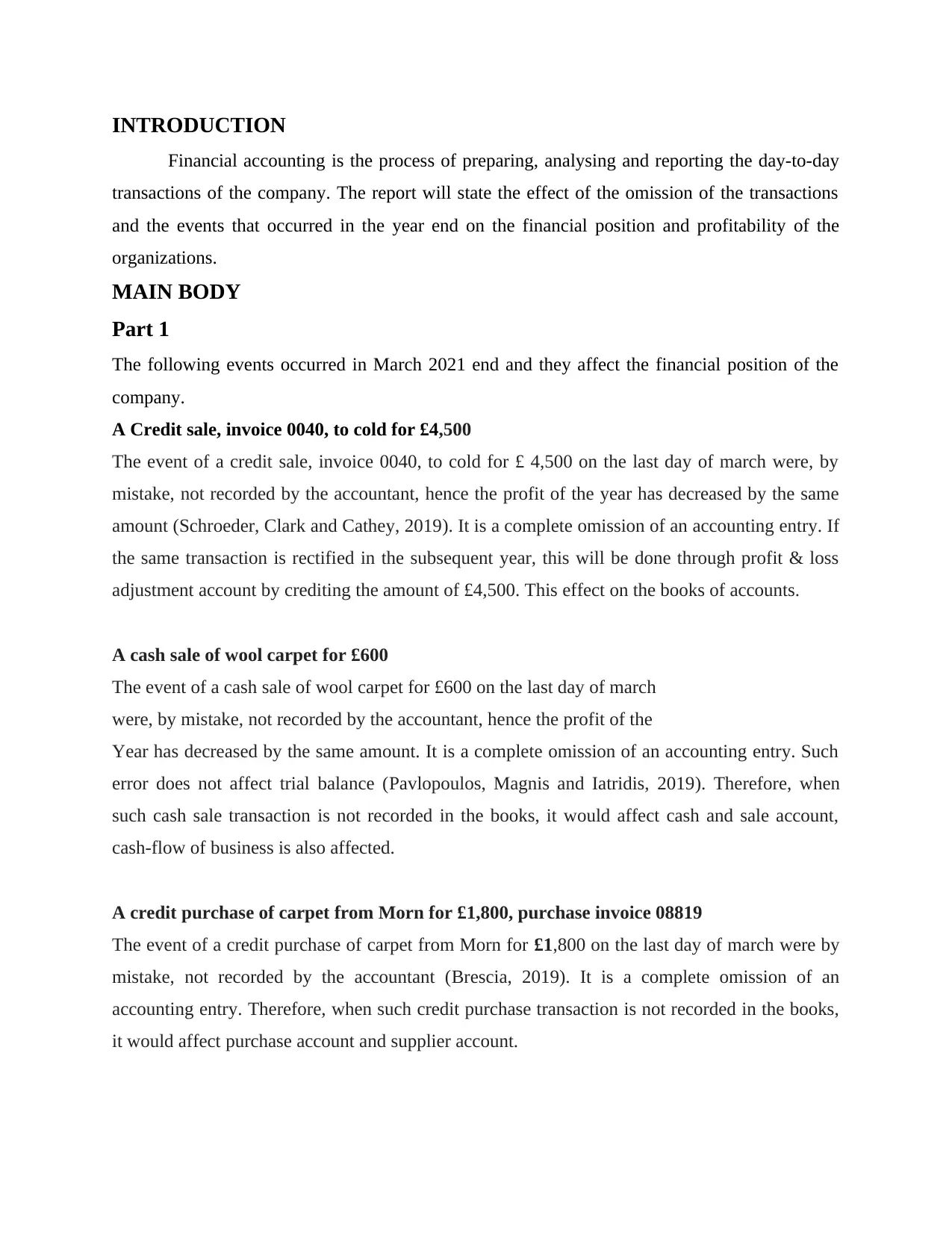
INTRODUCTION
Financial accounting is the process of preparing, analysing and reporting the day-to-day
transactions of the company. The report will state the effect of the omission of the transactions
and the events that occurred in the year end on the financial position and profitability of the
organizations.
MAIN BODY
Part 1
The following events occurred in March 2021 end and they affect the financial position of the
company.
A Credit sale, invoice 0040, to cold for £4,500
The event of a credit sale, invoice 0040, to cold for £ 4,500 on the last day of march were, by
mistake, not recorded by the accountant, hence the profit of the year has decreased by the same
amount (Schroeder, Clark and Cathey, 2019). It is a complete omission of an accounting entry. If
the same transaction is rectified in the subsequent year, this will be done through profit & loss
adjustment account by crediting the amount of £4,500. This effect on the books of accounts.
A cash sale of wool carpet for £600
The event of a cash sale of wool carpet for £600 on the last day of march
were, by mistake, not recorded by the accountant, hence the profit of the
Year has decreased by the same amount. It is a complete omission of an accounting entry. Such
error does not affect trial balance (Pavlopoulos, Magnis and Iatridis, 2019). Therefore, when
such cash sale transaction is not recorded in the books, it would affect cash and sale account,
cash-flow of business is also affected.
A credit purchase of carpet from Morn for £1,800, purchase invoice 08819
The event of a credit purchase of carpet from Morn for £1,800 on the last day of march were by
mistake, not recorded by the accountant (Brescia, 2019). It is a complete omission of an
accounting entry. Therefore, when such credit purchase transaction is not recorded in the books,
it would affect purchase account and supplier account.
Financial accounting is the process of preparing, analysing and reporting the day-to-day
transactions of the company. The report will state the effect of the omission of the transactions
and the events that occurred in the year end on the financial position and profitability of the
organizations.
MAIN BODY
Part 1
The following events occurred in March 2021 end and they affect the financial position of the
company.
A Credit sale, invoice 0040, to cold for £4,500
The event of a credit sale, invoice 0040, to cold for £ 4,500 on the last day of march were, by
mistake, not recorded by the accountant, hence the profit of the year has decreased by the same
amount (Schroeder, Clark and Cathey, 2019). It is a complete omission of an accounting entry. If
the same transaction is rectified in the subsequent year, this will be done through profit & loss
adjustment account by crediting the amount of £4,500. This effect on the books of accounts.
A cash sale of wool carpet for £600
The event of a cash sale of wool carpet for £600 on the last day of march
were, by mistake, not recorded by the accountant, hence the profit of the
Year has decreased by the same amount. It is a complete omission of an accounting entry. Such
error does not affect trial balance (Pavlopoulos, Magnis and Iatridis, 2019). Therefore, when
such cash sale transaction is not recorded in the books, it would affect cash and sale account,
cash-flow of business is also affected.
A credit purchase of carpet from Morn for £1,800, purchase invoice 08819
The event of a credit purchase of carpet from Morn for £1,800 on the last day of march were by
mistake, not recorded by the accountant (Brescia, 2019). It is a complete omission of an
accounting entry. Therefore, when such credit purchase transaction is not recorded in the books,
it would affect purchase account and supplier account.
⊘ This is a preview!⊘
Do you want full access?
Subscribe today to unlock all pages.

Trusted by 1+ million students worldwide
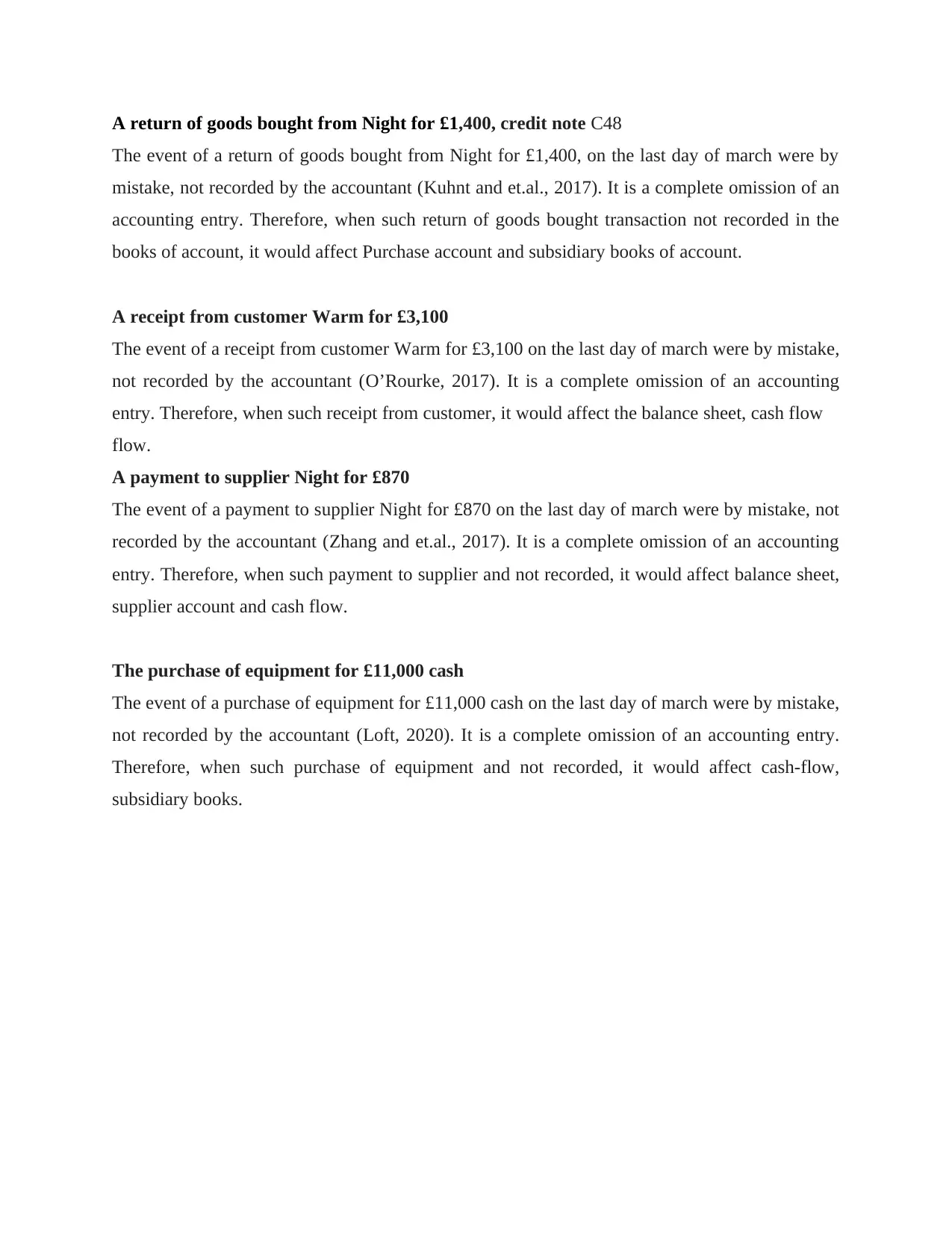
A return of goods bought from Night for £1,400, credit note C48
The event of a return of goods bought from Night for £1,400, on the last day of march were by
mistake, not recorded by the accountant (Kuhnt and et.al., 2017). It is a complete omission of an
accounting entry. Therefore, when such return of goods bought transaction not recorded in the
books of account, it would affect Purchase account and subsidiary books of account.
A receipt from customer Warm for £3,100
The event of a receipt from customer Warm for £3,100 on the last day of march were by mistake,
not recorded by the accountant (O’Rourke, 2017). It is a complete omission of an accounting
entry. Therefore, when such receipt from customer, it would affect the balance sheet, cash flow
flow.
A payment to supplier Night for £870
The event of a payment to supplier Night for £870 on the last day of march were by mistake, not
recorded by the accountant (Zhang and et.al., 2017). It is a complete omission of an accounting
entry. Therefore, when such payment to supplier and not recorded, it would affect balance sheet,
supplier account and cash flow.
The purchase of equipment for £11,000 cash
The event of a purchase of equipment for £11,000 cash on the last day of march were by mistake,
not recorded by the accountant (Loft, 2020). It is a complete omission of an accounting entry.
Therefore, when such purchase of equipment and not recorded, it would affect cash-flow,
subsidiary books.
The event of a return of goods bought from Night for £1,400, on the last day of march were by
mistake, not recorded by the accountant (Kuhnt and et.al., 2017). It is a complete omission of an
accounting entry. Therefore, when such return of goods bought transaction not recorded in the
books of account, it would affect Purchase account and subsidiary books of account.
A receipt from customer Warm for £3,100
The event of a receipt from customer Warm for £3,100 on the last day of march were by mistake,
not recorded by the accountant (O’Rourke, 2017). It is a complete omission of an accounting
entry. Therefore, when such receipt from customer, it would affect the balance sheet, cash flow
flow.
A payment to supplier Night for £870
The event of a payment to supplier Night for £870 on the last day of march were by mistake, not
recorded by the accountant (Zhang and et.al., 2017). It is a complete omission of an accounting
entry. Therefore, when such payment to supplier and not recorded, it would affect balance sheet,
supplier account and cash flow.
The purchase of equipment for £11,000 cash
The event of a purchase of equipment for £11,000 cash on the last day of march were by mistake,
not recorded by the accountant (Loft, 2020). It is a complete omission of an accounting entry.
Therefore, when such purchase of equipment and not recorded, it would affect cash-flow,
subsidiary books.
Paraphrase This Document
Need a fresh take? Get an instant paraphrase of this document with our AI Paraphraser
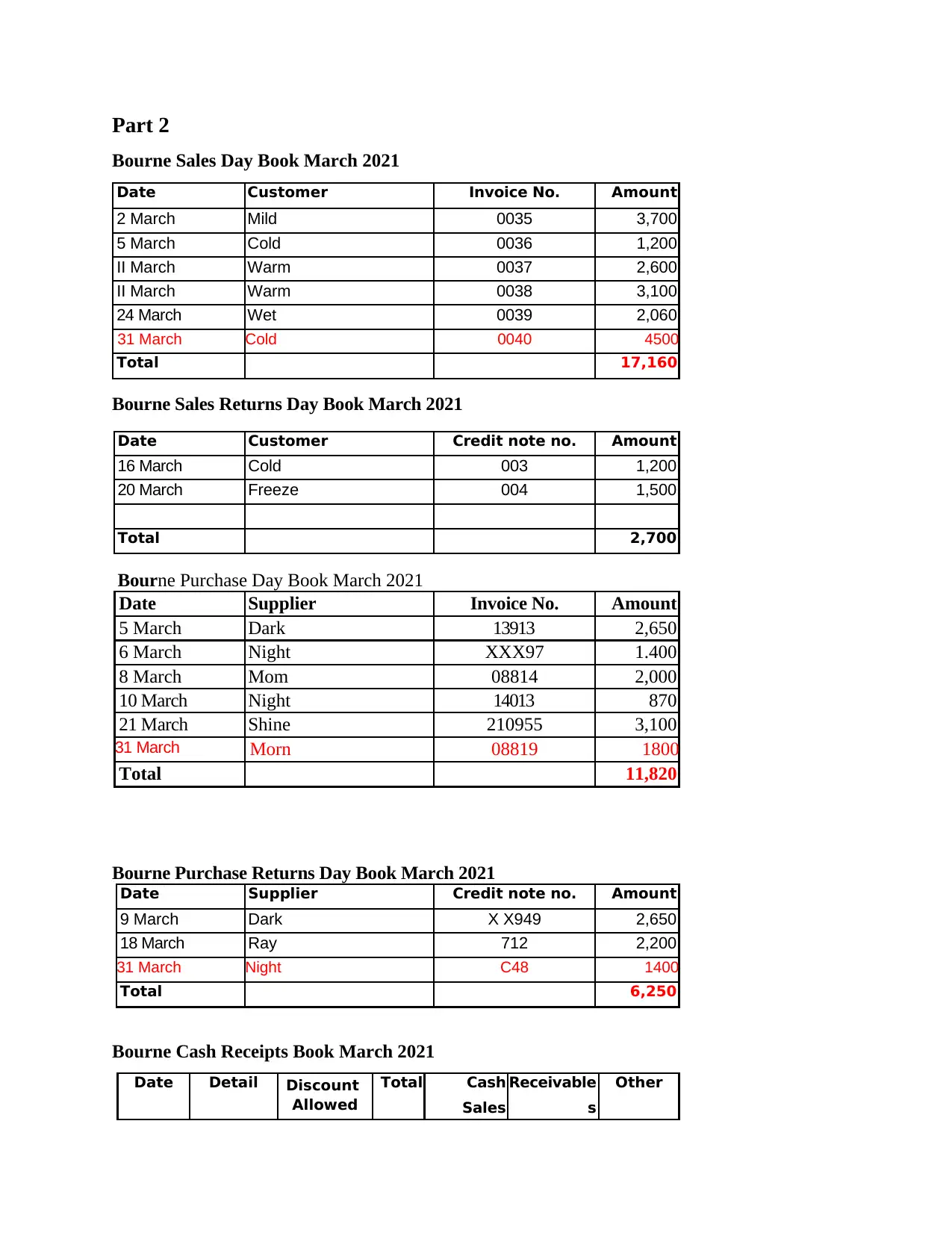
Part 2
Bourne Sales Day Book March 2021
Date Customer Invoice No. Amount
2 March Mild 0035 3,700
5 March Cold 0036 1,200
II March Warm 0037 2,600
II March Warm 0038 3,100
24 March Wet 0039 2,060
31 March Cold 0040 4500
Total 17,160
Bourne Sales Returns Day Book March 2021
Date Customer Credit note no. Amount
16 March Cold 003 1,200
20 March Freeze 004 1,500
Total 2,700
Bourne Purchase Day Book March 2021
Date Supplier Invoice No. Amount
5 March Dark 13913 2,650
6 March Night XXX97 1.400
8 March Mom 08814 2,000
10 March Night 14013 870
21 March Shine 210955 3,100
31 March Morn 08819 1800
Total 11,820
Bourne Purchase Returns Day Book March 2021
Date Supplier Credit note no. Amount
9 March Dark X X949 2,650
18 March Ray 712 2,200
31 March Night C48 1400
Total 6,250
Bourne Cash Receipts Book March 2021
Date Detail Discount
Allowed
Total Cash
Sales
Receivable
s
Other
Bourne Sales Day Book March 2021
Date Customer Invoice No. Amount
2 March Mild 0035 3,700
5 March Cold 0036 1,200
II March Warm 0037 2,600
II March Warm 0038 3,100
24 March Wet 0039 2,060
31 March Cold 0040 4500
Total 17,160
Bourne Sales Returns Day Book March 2021
Date Customer Credit note no. Amount
16 March Cold 003 1,200
20 March Freeze 004 1,500
Total 2,700
Bourne Purchase Day Book March 2021
Date Supplier Invoice No. Amount
5 March Dark 13913 2,650
6 March Night XXX97 1.400
8 March Mom 08814 2,000
10 March Night 14013 870
21 March Shine 210955 3,100
31 March Morn 08819 1800
Total 11,820
Bourne Purchase Returns Day Book March 2021
Date Supplier Credit note no. Amount
9 March Dark X X949 2,650
18 March Ray 712 2,200
31 March Night C48 1400
Total 6,250
Bourne Cash Receipts Book March 2021
Date Detail Discount
Allowed
Total Cash
Sales
Receivable
s
Other
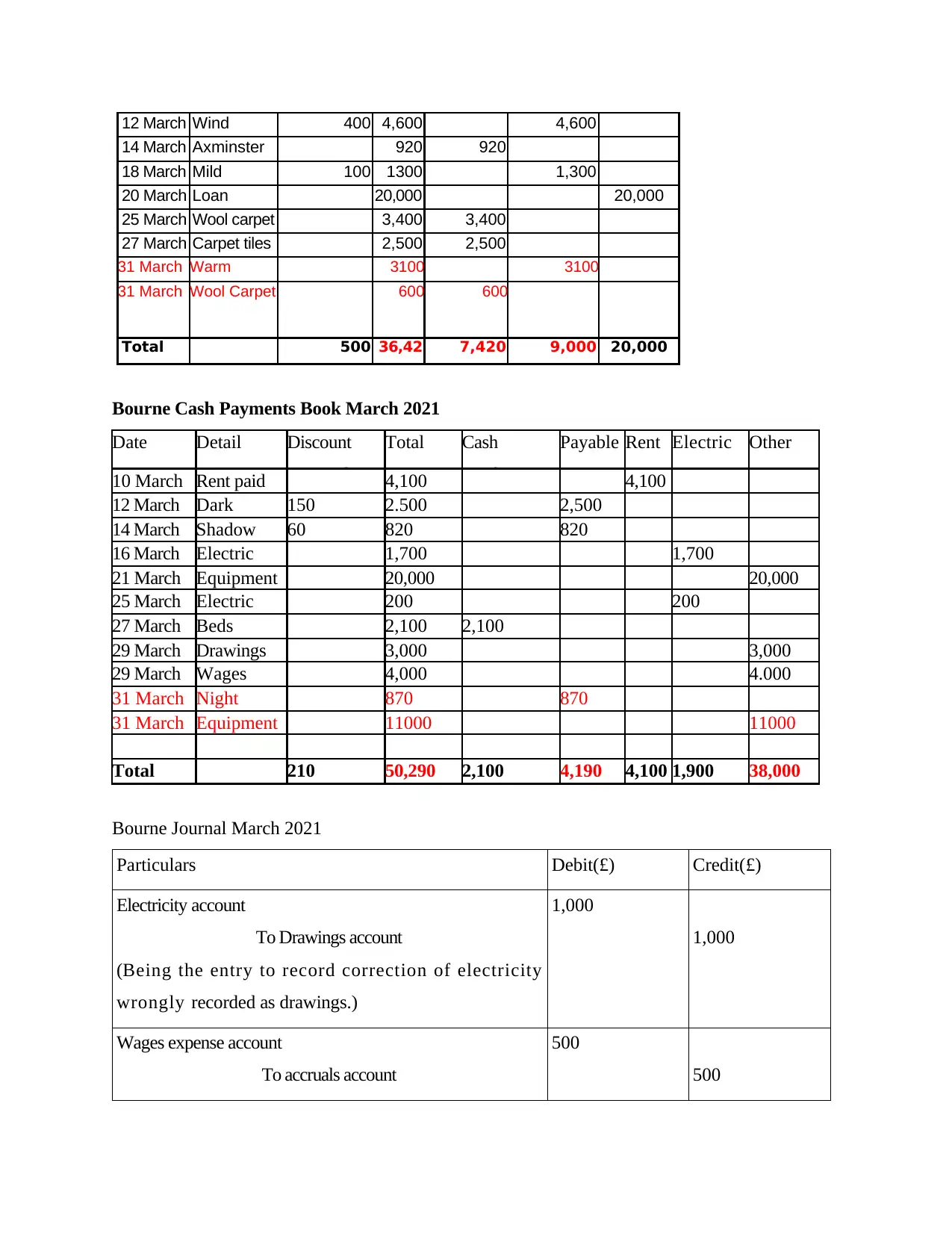
12 March Wind 400 4,600 4,600
14 March Axminster 920 920
18 March Mild 100 1300 1,300
20 March Loan 20,000 20,000
25 March Wool carpet 3,400 3,400
27 March Carpet tiles 2,500 2,500
31 March Warm 3100 3100
31 March Wool Carpet 600 600
Total 500 36,42
0
7,420 9,000 20,000
Bourne Cash Payments Book March 2021
Date Detail Discount
received
Total Cash
purchases
Payable
s
Rent Electric Other
10 March Rent paid 4,100 4,100
12 March Dark 150 2.500 2,500
14 March Shadow 60 820 820
16 March Electric 1,700 1,700
21 March Equipment 20,000 20,000
25 March Electric 200 200
27 March Beds 2,100 2,100
29 March Drawings 3,000 3,000
29 March Wages 4,000 4.000
31 March Night 870 870
31 March Equipment 11000 11000
Total 210 50,290 2,100 4,190 4,100 1,900 38,000
Bourne Journal March 2021
Particulars Debit(£) Credit(£)
Electricity account
To Drawings account
(Being the entry to record correction of electricity
wrongly recorded as drawings.)
1,000
1,000
Wages expense account
To accruals account
500
500
14 March Axminster 920 920
18 March Mild 100 1300 1,300
20 March Loan 20,000 20,000
25 March Wool carpet 3,400 3,400
27 March Carpet tiles 2,500 2,500
31 March Warm 3100 3100
31 March Wool Carpet 600 600
Total 500 36,42
0
7,420 9,000 20,000
Bourne Cash Payments Book March 2021
Date Detail Discount
received
Total Cash
purchases
Payable
s
Rent Electric Other
10 March Rent paid 4,100 4,100
12 March Dark 150 2.500 2,500
14 March Shadow 60 820 820
16 March Electric 1,700 1,700
21 March Equipment 20,000 20,000
25 March Electric 200 200
27 March Beds 2,100 2,100
29 March Drawings 3,000 3,000
29 March Wages 4,000 4.000
31 March Night 870 870
31 March Equipment 11000 11000
Total 210 50,290 2,100 4,190 4,100 1,900 38,000
Bourne Journal March 2021
Particulars Debit(£) Credit(£)
Electricity account
To Drawings account
(Being the entry to record correction of electricity
wrongly recorded as drawings.)
1,000
1,000
Wages expense account
To accruals account
500
500
⊘ This is a preview!⊘
Do you want full access?
Subscribe today to unlock all pages.

Trusted by 1+ million students worldwide
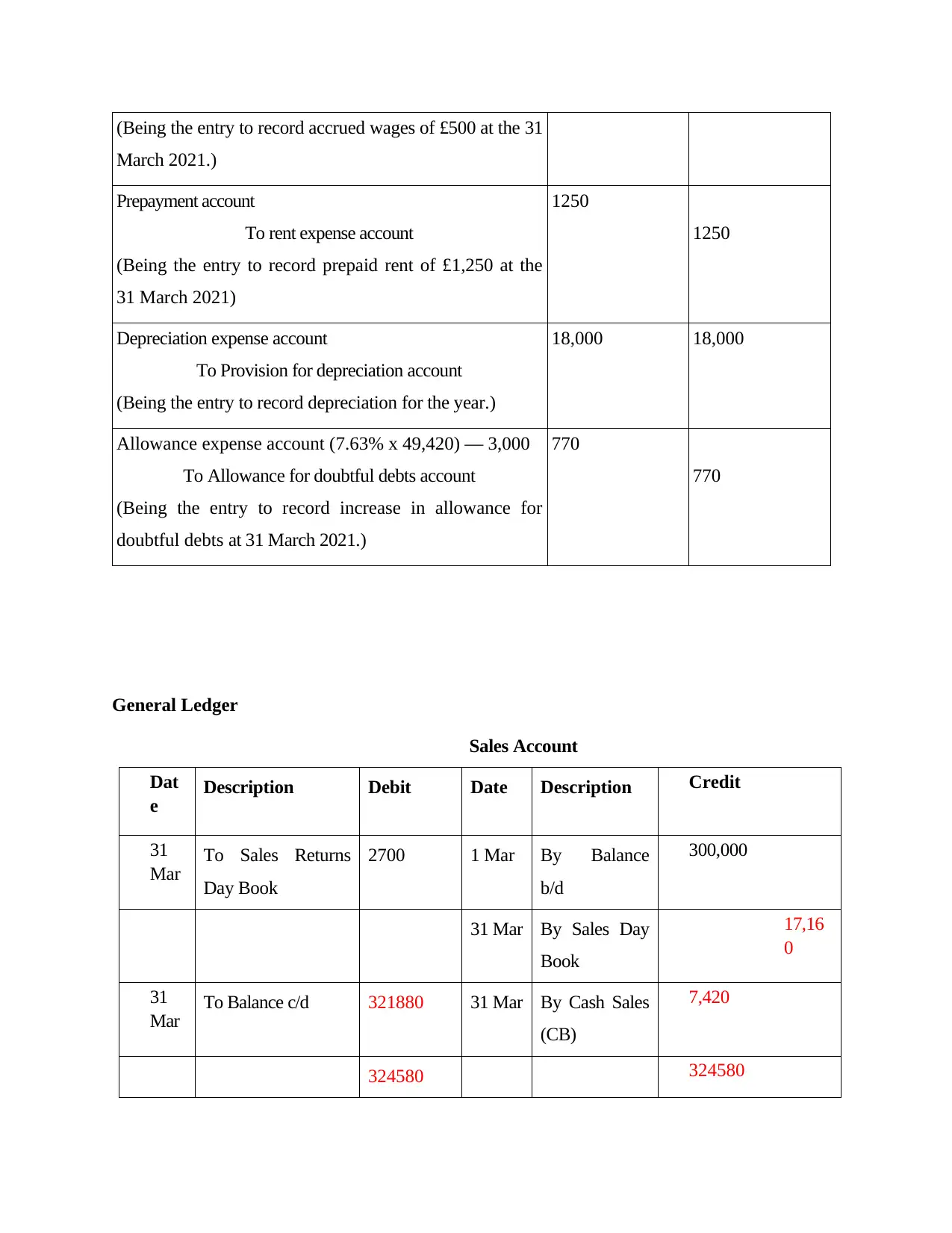
(Being the entry to record accrued wages of £500 at the 31
March 2021.)
Prepayment account
To rent expense account
(Being the entry to record prepaid rent of £1,250 at the
31 March 2021)
1250
1250
Depreciation expense account
To Provision for depreciation account
(Being the entry to record depreciation for the year.)
18,000 18,000
Allowance expense account (7.63% x 49,420) — 3,000
To Allowance for doubtful debts account
(Being the entry to record increase in allowance for
doubtful debts at 31 March 2021.)
770
770
General Ledger
Sales Account
Dat
e Description Debit Date Description Credit
31
Mar To Sales Returns
Day Book
2700 1 Mar By Balance
b/d
300,000
31 Mar By Sales Day
Book
17,16
0
31
Mar To Balance c/d 321880 31 Mar By Cash Sales
(CB)
7,420
324580 324580
March 2021.)
Prepayment account
To rent expense account
(Being the entry to record prepaid rent of £1,250 at the
31 March 2021)
1250
1250
Depreciation expense account
To Provision for depreciation account
(Being the entry to record depreciation for the year.)
18,000 18,000
Allowance expense account (7.63% x 49,420) — 3,000
To Allowance for doubtful debts account
(Being the entry to record increase in allowance for
doubtful debts at 31 March 2021.)
770
770
General Ledger
Sales Account
Dat
e Description Debit Date Description Credit
31
Mar To Sales Returns
Day Book
2700 1 Mar By Balance
b/d
300,000
31 Mar By Sales Day
Book
17,16
0
31
Mar To Balance c/d 321880 31 Mar By Cash Sales
(CB)
7,420
324580 324580
Paraphrase This Document
Need a fresh take? Get an instant paraphrase of this document with our AI Paraphraser
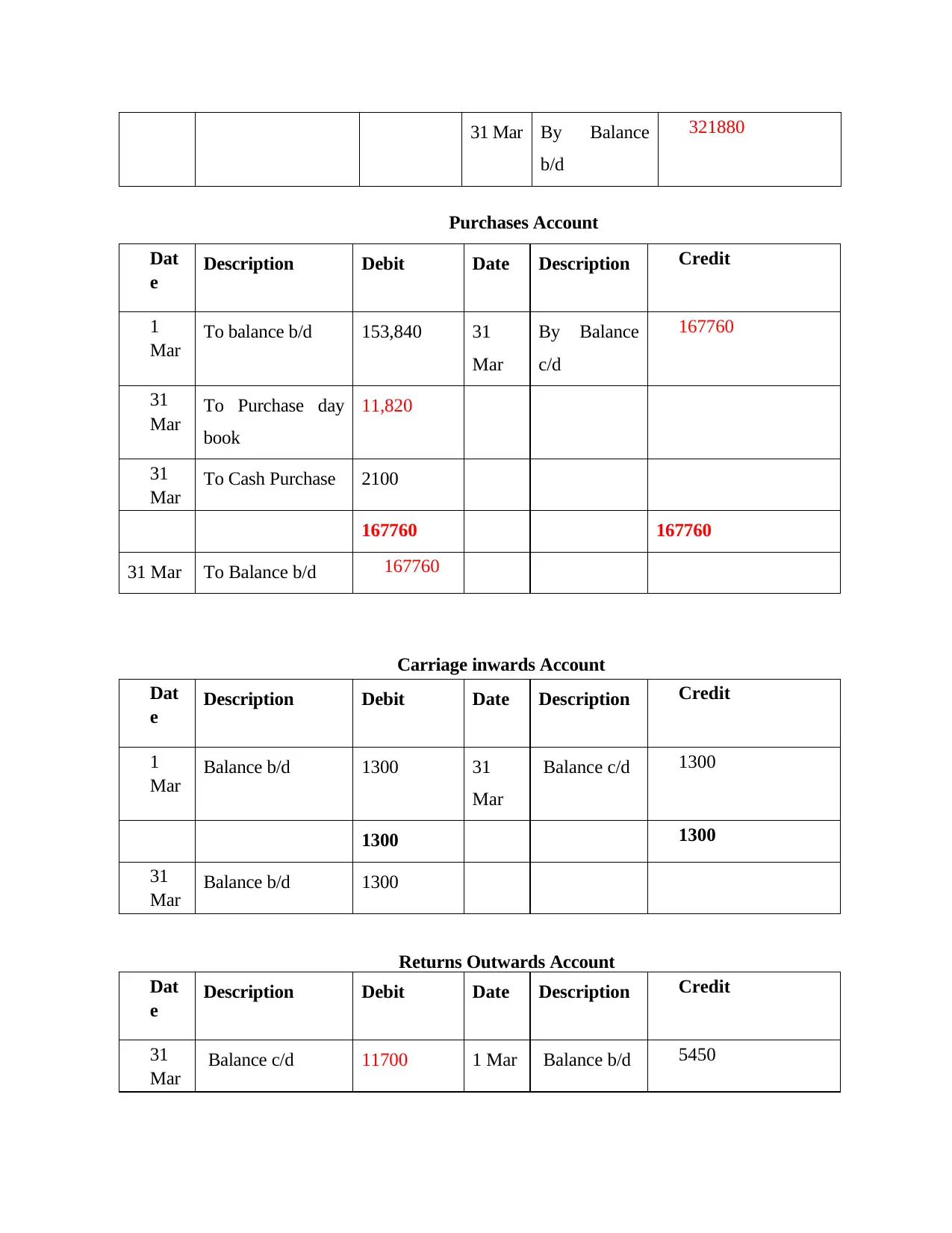
31 Mar By Balance
b/d
321880
Purchases Account
Dat
e Description Debit Date Description Credit
1
Mar To balance b/d 153,840 31
Mar
By Balance
c/d
167760
31
Mar To Purchase day
book
11,820
31
Mar To Cash Purchase 2100
167760 167760
31 Mar To Balance b/d 167760
Carriage inwards Account
Dat
e Description Debit Date Description Credit
1
Mar Balance b/d 1300 31
Mar
Balance c/d 1300
1300 1300
31
Mar Balance b/d 1300
Returns Outwards Account
Dat
e Description Debit Date Description Credit
31
Mar Balance c/d 11700 1 Mar Balance b/d 5450
b/d
321880
Purchases Account
Dat
e Description Debit Date Description Credit
1
Mar To balance b/d 153,840 31
Mar
By Balance
c/d
167760
31
Mar To Purchase day
book
11,820
31
Mar To Cash Purchase 2100
167760 167760
31 Mar To Balance b/d 167760
Carriage inwards Account
Dat
e Description Debit Date Description Credit
1
Mar Balance b/d 1300 31
Mar
Balance c/d 1300
1300 1300
31
Mar Balance b/d 1300
Returns Outwards Account
Dat
e Description Debit Date Description Credit
31
Mar Balance c/d 11700 1 Mar Balance b/d 5450
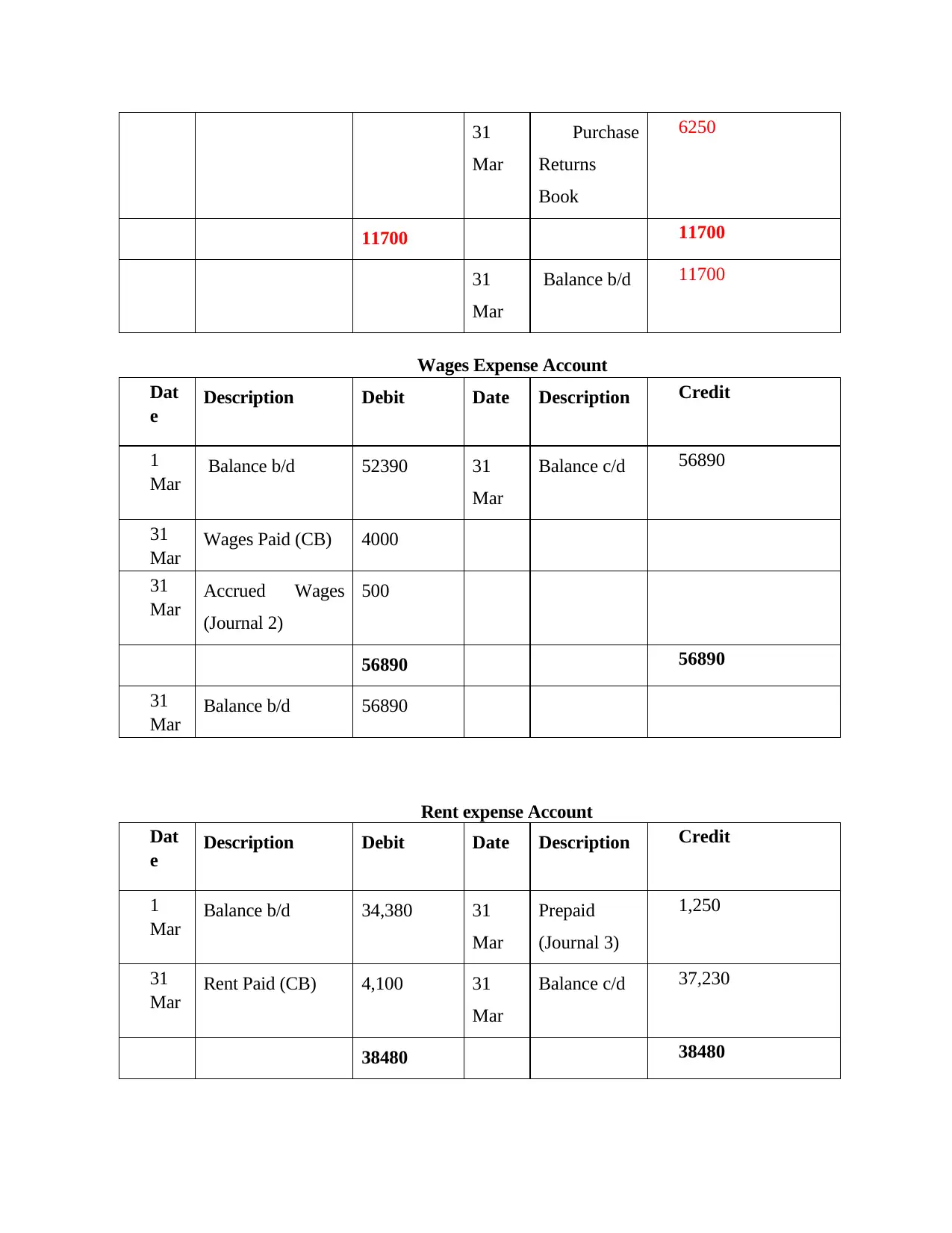
31
Mar
Purchase
Returns
Book
6250
11700 11700
31
Mar
Balance b/d 11700
Wages Expense Account
Dat
e Description Debit Date Description Credit
1
Mar Balance b/d 52390 31
Mar
Balance c/d 56890
31
Mar Wages Paid (CB) 4000
31
Mar Accrued Wages
(Journal 2)
500
56890 56890
31
Mar Balance b/d 56890
Rent expense Account
Dat
e Description Debit Date Description Credit
1
Mar Balance b/d 34,380 31
Mar
Prepaid
(Journal 3)
1,250
31
Mar Rent Paid (CB) 4,100 31
Mar
Balance c/d 37,230
38480 38480
Mar
Purchase
Returns
Book
6250
11700 11700
31
Mar
Balance b/d 11700
Wages Expense Account
Dat
e Description Debit Date Description Credit
1
Mar Balance b/d 52390 31
Mar
Balance c/d 56890
31
Mar Wages Paid (CB) 4000
31
Mar Accrued Wages
(Journal 2)
500
56890 56890
31
Mar Balance b/d 56890
Rent expense Account
Dat
e Description Debit Date Description Credit
1
Mar Balance b/d 34,380 31
Mar
Prepaid
(Journal 3)
1,250
31
Mar Rent Paid (CB) 4,100 31
Mar
Balance c/d 37,230
38480 38480
⊘ This is a preview!⊘
Do you want full access?
Subscribe today to unlock all pages.

Trusted by 1+ million students worldwide
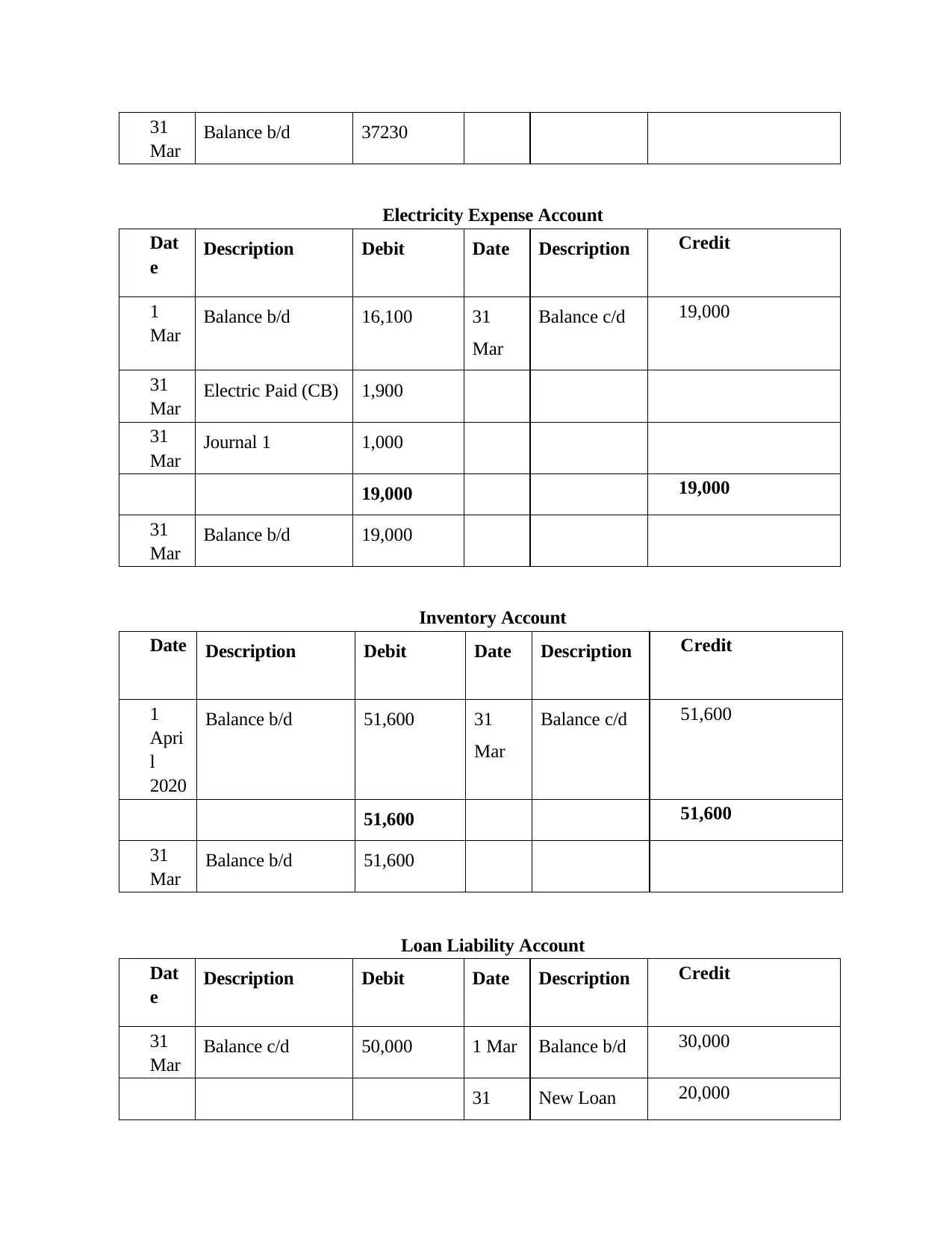
31
Mar Balance b/d 37230
Electricity Expense Account
Dat
e Description Debit Date Description Credit
1
Mar Balance b/d 16,100 31
Mar
Balance c/d 19,000
31
Mar Electric Paid (CB) 1,900
31
Mar Journal 1 1,000
19,000 19,000
31
Mar Balance b/d 19,000
Inventory Account
Date Description Debit Date Description Credit
1
Apri
l
2020
Balance b/d 51,600 31
Mar
Balance c/d 51,600
51,600 51,600
31
Mar Balance b/d 51,600
Loan Liability Account
Dat
e Description Debit Date Description Credit
31
Mar Balance c/d 50,000 1 Mar Balance b/d 30,000
31 New Loan 20,000
Mar Balance b/d 37230
Electricity Expense Account
Dat
e Description Debit Date Description Credit
1
Mar Balance b/d 16,100 31
Mar
Balance c/d 19,000
31
Mar Electric Paid (CB) 1,900
31
Mar Journal 1 1,000
19,000 19,000
31
Mar Balance b/d 19,000
Inventory Account
Date Description Debit Date Description Credit
1
Apri
l
2020
Balance b/d 51,600 31
Mar
Balance c/d 51,600
51,600 51,600
31
Mar Balance b/d 51,600
Loan Liability Account
Dat
e Description Debit Date Description Credit
31
Mar Balance c/d 50,000 1 Mar Balance b/d 30,000
31 New Loan 20,000
Paraphrase This Document
Need a fresh take? Get an instant paraphrase of this document with our AI Paraphraser
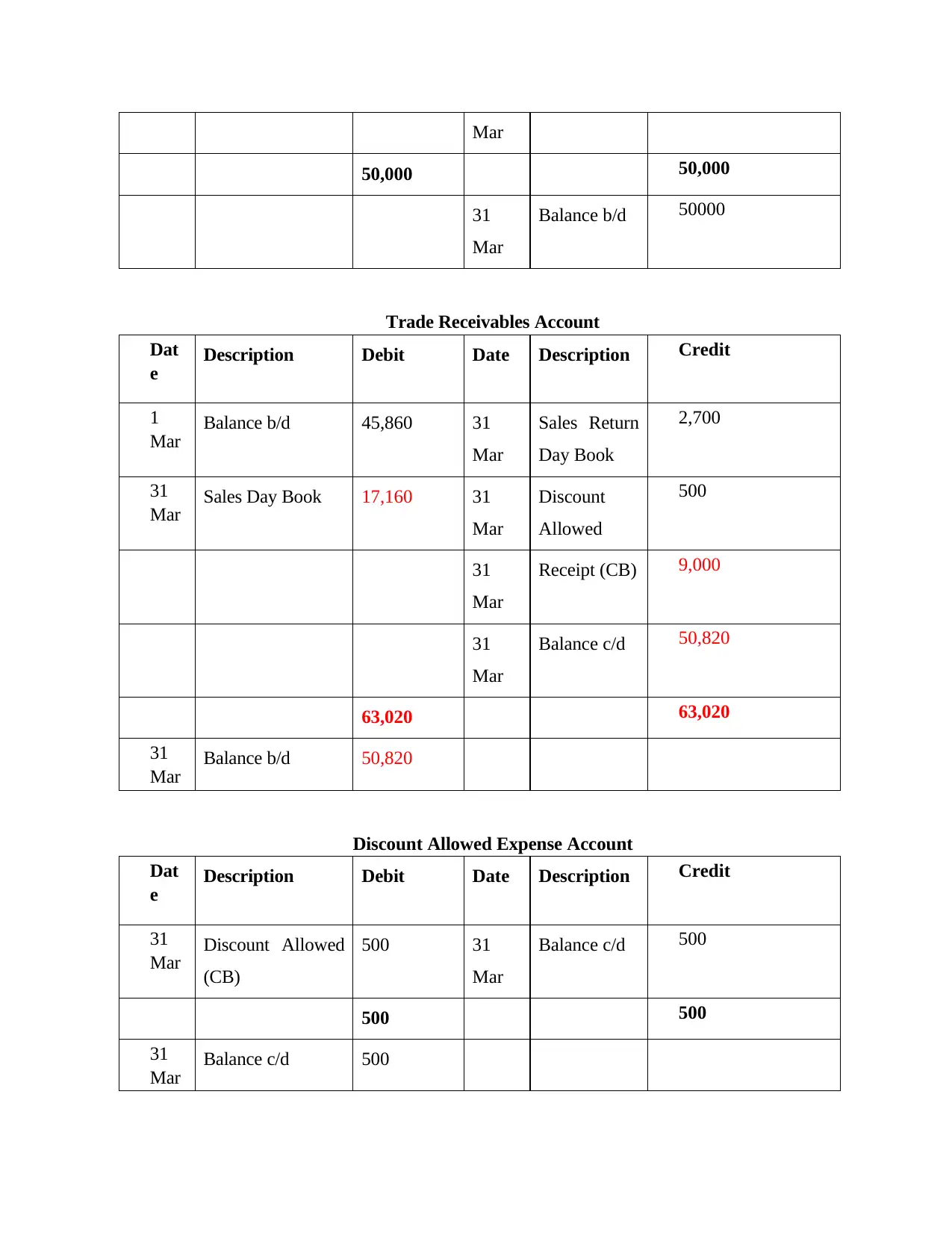
Mar
50,000 50,000
31
Mar
Balance b/d 50000
Trade Receivables Account
Dat
e Description Debit Date Description Credit
1
Mar Balance b/d 45,860 31
Mar
Sales Return
Day Book
2,700
31
Mar Sales Day Book 17,160 31
Mar
Discount
Allowed
500
31
Mar
Receipt (CB) 9,000
31
Mar
Balance c/d 50,820
63,020 63,020
31
Mar Balance b/d 50,820
Discount Allowed Expense Account
Dat
e Description Debit Date Description Credit
31
Mar Discount Allowed
(CB)
500 31
Mar
Balance c/d 500
500 500
31
Mar Balance c/d 500
50,000 50,000
31
Mar
Balance b/d 50000
Trade Receivables Account
Dat
e Description Debit Date Description Credit
1
Mar Balance b/d 45,860 31
Mar
Sales Return
Day Book
2,700
31
Mar Sales Day Book 17,160 31
Mar
Discount
Allowed
500
31
Mar
Receipt (CB) 9,000
31
Mar
Balance c/d 50,820
63,020 63,020
31
Mar Balance b/d 50,820
Discount Allowed Expense Account
Dat
e Description Debit Date Description Credit
31
Mar Discount Allowed
(CB)
500 31
Mar
Balance c/d 500
500 500
31
Mar Balance c/d 500
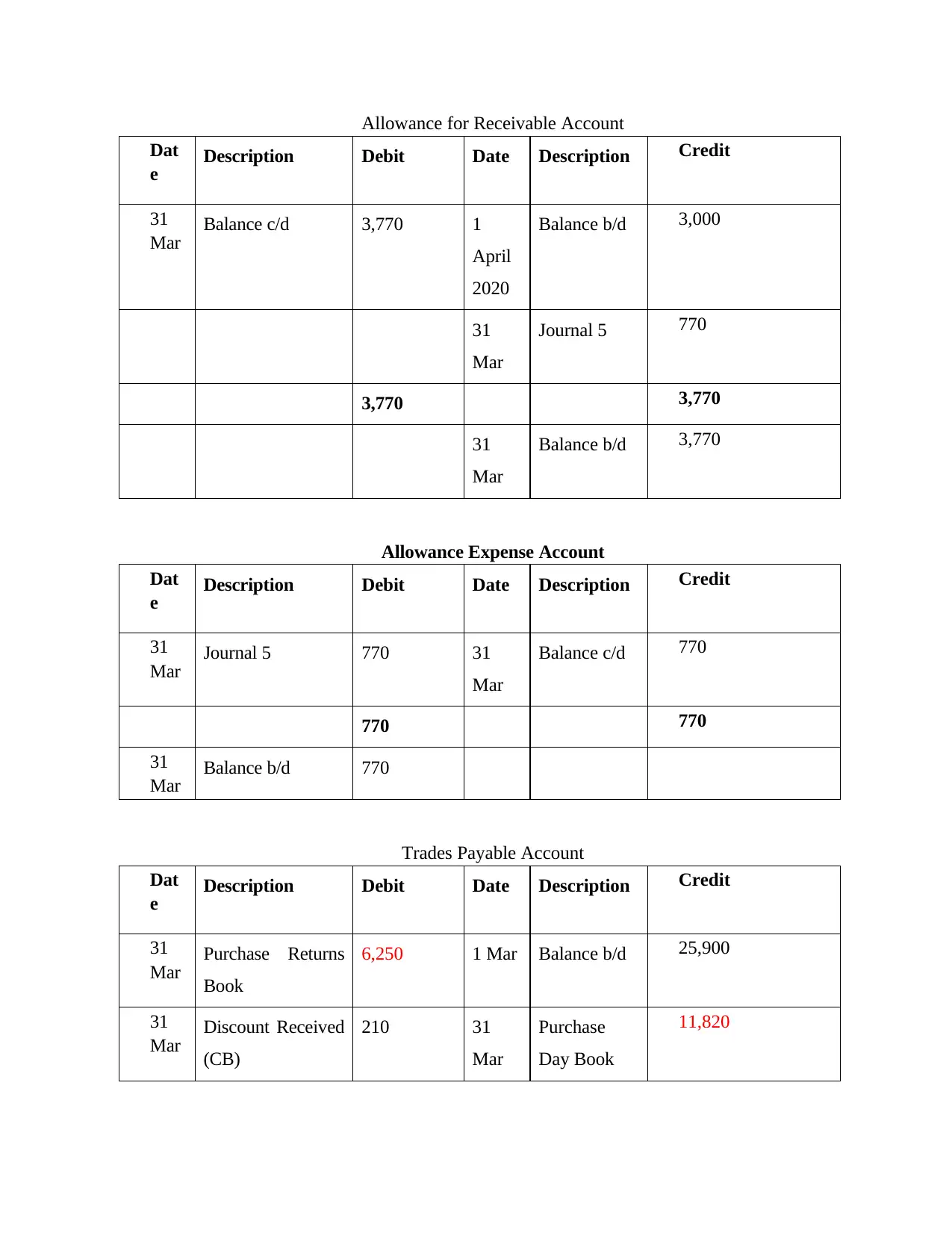
Allowance for Receivable Account
Dat
e Description Debit Date Description Credit
31
Mar Balance c/d 3,770 1
April
2020
Balance b/d 3,000
31
Mar
Journal 5 770
3,770 3,770
31
Mar
Balance b/d 3,770
Allowance Expense Account
Dat
e Description Debit Date Description Credit
31
Mar Journal 5 770 31
Mar
Balance c/d 770
770 770
31
Mar Balance b/d 770
Trades Payable Account
Dat
e Description Debit Date Description Credit
31
Mar Purchase Returns
Book
6,250 1 Mar Balance b/d 25,900
31
Mar Discount Received
(CB)
210 31
Mar
Purchase
Day Book
11,820
Dat
e Description Debit Date Description Credit
31
Mar Balance c/d 3,770 1
April
2020
Balance b/d 3,000
31
Mar
Journal 5 770
3,770 3,770
31
Mar
Balance b/d 3,770
Allowance Expense Account
Dat
e Description Debit Date Description Credit
31
Mar Journal 5 770 31
Mar
Balance c/d 770
770 770
31
Mar Balance b/d 770
Trades Payable Account
Dat
e Description Debit Date Description Credit
31
Mar Purchase Returns
Book
6,250 1 Mar Balance b/d 25,900
31
Mar Discount Received
(CB)
210 31
Mar
Purchase
Day Book
11,820
⊘ This is a preview!⊘
Do you want full access?
Subscribe today to unlock all pages.

Trusted by 1+ million students worldwide
1 out of 22
Related Documents
Your All-in-One AI-Powered Toolkit for Academic Success.
+13062052269
info@desklib.com
Available 24*7 on WhatsApp / Email
![[object Object]](/_next/static/media/star-bottom.7253800d.svg)
Unlock your academic potential
Copyright © 2020–2025 A2Z Services. All Rights Reserved. Developed and managed by ZUCOL.





